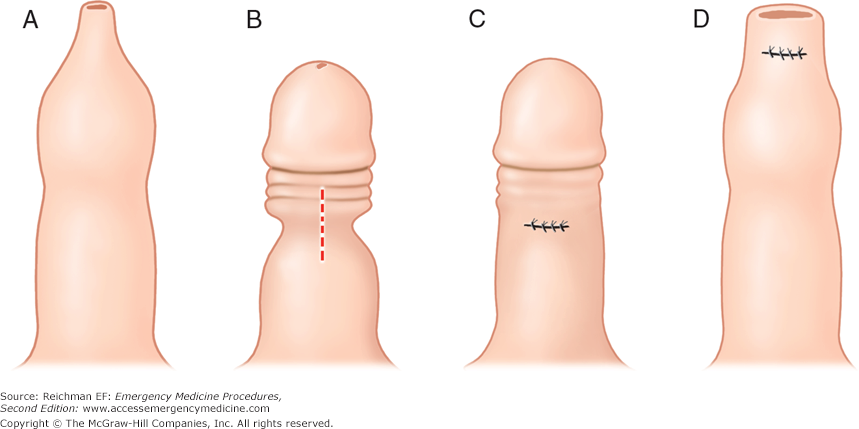

Redness of the foreskin or head of the penis can be due to either benign inflammation (such as Zoon’s balanitis or BXO), infection (bacterial or fungal), or rarely pre-cancerous changes (CIS / Erythroplasia of Queryat).
If you do experience a persistent or painful red area on the tip of the penis then it is best to seek the advice of your GP, and if necessary referral to a specialist. If you feel that you are at risk of a STD, then a visit to your local sexual health clinic may be necessary.
Infections and inflammatory problems are often managed with topical creams to start with, but if there is doubt as to the diagnosis, or suspicion of something more serious, then a penile biopsy may be indicated for clarification.
Ongoing foreskin problems may be best served by a circumcision, and rarely severe and chronic inflammatory changes on the head of the penis that have failed to respond to topical treatments may ultimately require a small split-skin graft – a procedure known as Glans Resurfacing.
A fairly common cause of redness, pain +/- white scarring of the penis is lichen sclerosus (or Balanitis Xerotica Obliterans – BXO). This is not an infection, and the cause is not well understood. However it is commoner in diabetic and overweight men.
BXO may start as a red or painful area of the foreskin or head of penis (glans), which does not respond to antibiotic or anti-fungal creams. It can progress to white scarring or pale areas on the head of the penis, eventually causing tightness of the foreskin. In the early phase of the problem, a short course of steroid cream may be useful in reversing the inflammatory changes, but once scar tissue has formed, creams are less useful.
The vast majority of men with foreskin problems associated with BXO are cured by a circumcision, but a small proportion will develop further scarring requiring more extensive surgery such as skin grafts. There is a very small risk of cancerous changes in men with untreated persistent / severe BXO, and it is therefore best to have it treated in the early phase.
Thankfully penile cancer is a rare disease affecting around 600 men per year in the UK. It will usually present as a progressive red area that fails to respond to topical medical treatments, ulcerated or bleeding lesions, or a raised area or lump. If there is doubt then an urgent biopsy is indicated, and treatment is usually surgery aimed at preserving as much of the penis as possible.
For further information on penile cancer please click the More Details button below.
A tight foreskin can develop in childhood, and if so often resolves spontaneously with growth and development. However lack of resolution or urinary infections or recurrent infections of the head of the penis may necessitate circumcision.
The commonest reason for medical circumcision in adulthood is a tight foreskin, which may be causing pain, difficulty passing urine or difficulty with sexual intercourse. Other indications are recurrent infections, inflammatory conditions such as lichen sclerosus (also termed BXO – Balanitis Xerotica Obliterans), scarring, and more rarely – penile cancer or pre-cancer.
This is usually performed in an emergency situation where the foreskin has become so tight that passing urine has become impossible (acute retention). It involves making a cut down the foreskin to revela the glans (head ) of the penis, but it does leave an unsightly appearance, usually requiring a subsequent circumcision.
Occasionally the band of skin linking the underneath of the head of the penis to the penile skin (frenulum) is tight or becomes tight after tearing / injury, and the remainder of the foreskin is unaffected and normal. In this case it may be appropriate to cut the frenulum under a local or general anaesthetic, and stitch it in such a way as to elongate it and get rid of the tightness. This appeals to many as it avoids removal of the foreskin, but it is not an effective treatment if there are is associated foreskin tightness or inflammation.
This is an uncommonly performed procedure which involves cutting the skin and muscle within the foreskin in an attempt to widen and loosen it, thus avoiding circumcision. Unfortunately the results are not as good as for circumcision, with over 50% ultimately returning requiring circumcision.

 |
07552 775247 |
 |
office@rowlandrees.com |
 |
Follow us on twitter |

Company Registration in England and Wales Company Registration: 07712943
Registered Address: Station House, North Street,
Havant, Hampshire, PO9 1QU
Members of:





